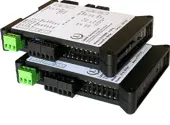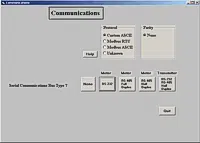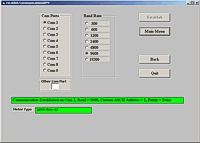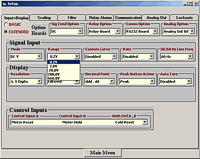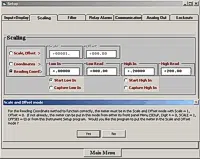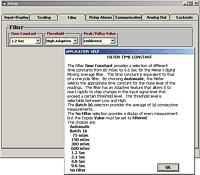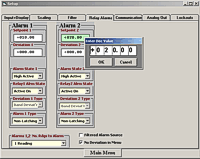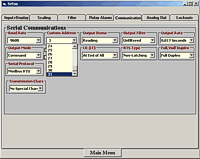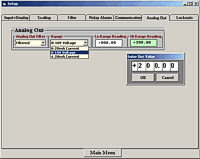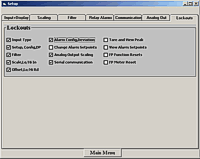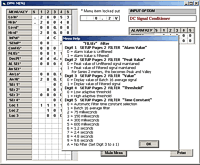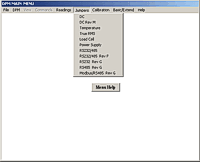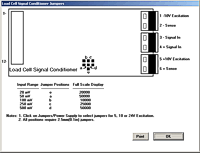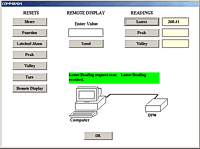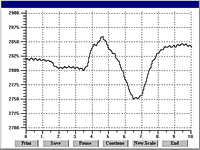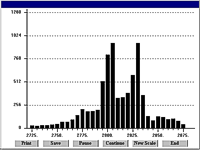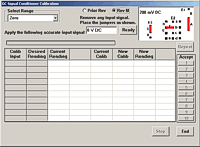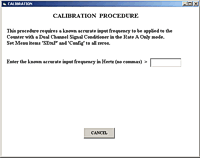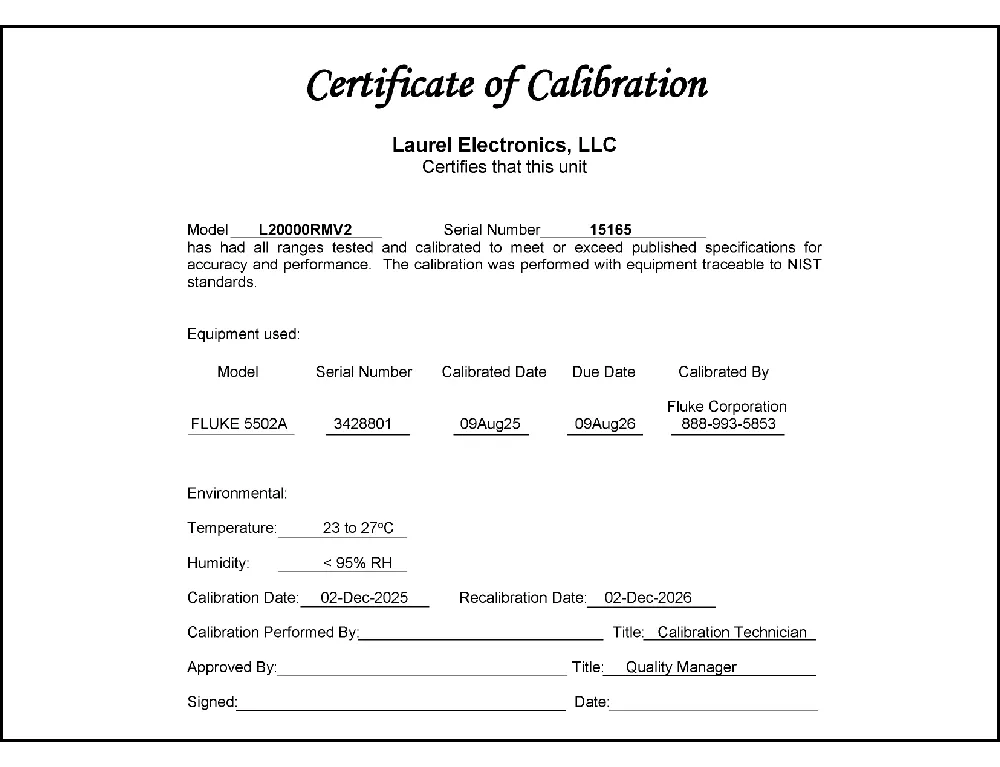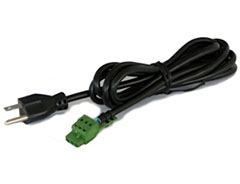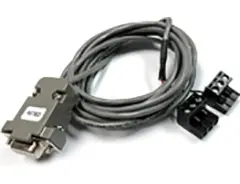Features
- 0.2, 2, 20, 200, 300 and 600V AC voltage ranges
- 2, 20, 200 mA & 5A AC or AC+DC current ranges
- Accuracy to 0.03% of full scale, 0.1% to 100% of FS, 10 Hz to 5 kHz
- 0.03% accuracy of full scale at crest factor to 3.0
- True RMS AC measurement with crest factor of 3.0 at full scale
- Measurements from 0% to 100% of full scale
- AC or DC coupling for signals from DC to 5 kHz
- Fast response: reading in 0-16.7 ms after each signal cycle to full accuracy
- All input ranges are user selectable and factory calibrated
- Up to 60 conversions per second, Ideal for peak or valley capture
- 4-20 mA, 0-20 mA, 0-10V or -10V to +10V transmitter output, (isolated)
- Analog output resolution 0.0015% of span, accuracy ±0.02% of span
- RS232 or RS485 serial data, Modbus or Laurel ASCII protocol (isolated)
- Dual 120 mA solid state relays for alarm or control (isolated)
- Power 85-264 Vac / 90-300 Vdc or 10-48 Vdc / 12-32 Vac (isolated)
- DIN rail mount housing, 22.5 mm wide, detachable screw-clamp connectors
- Operating temperature from -40°C to 70°C (-40°F to 158°F)
Optional - Extended allows up to 180 data points for custom curve linearization and a rate derived from consecutive readings.
Certificates of Compliance
The Laureate™ LT Series DIN rail analog transmitter with serial data communication and analog outputs for versatile connectivity.
The digitally programmable transmitter features two relays for alarm or control. The series offers exceptional accuracy of 0.01% of reading ± 2 counts, with high read rates at up to 60 or 50 conversions per second. The LT Series transmitters offer the same high performance, signal conditioning, and programmable features as Laureate digital panel meters, counters, and timers.The Laureate 4-20 mA, 0-20 mA, 0-10V or -10V to +10V and RS232/RS485 output transmitter for true RMS AC voltage or current input offers the same high performance, signal conditioning, and programmable features as Laureate digital panel meters, counters, and timers. It provides six voltage input ranges and four current input
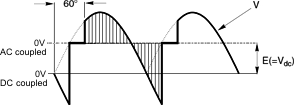 ranges, all factory calibrated and jumper selectable. A special 5.000A range utilizes a built-in 0.01 ohm shunt to accept the output of 5A current transformers, eliminating the need for a step-down transformer. The voltage readings can be scaled digitally as needed. High common mode rejection allows for stable readings with current shunts located on the high side of the line. Digital filtering is selectable for noisy signals.
ranges, all factory calibrated and jumper selectable. A special 5.000A range utilizes a built-in 0.01 ohm shunt to accept the output of 5A current transformers, eliminating the need for a step-down transformer. The voltage readings can be scaled digitally as needed. High common mode rejection allows for stable readings with current shunts located on the high side of the line. Digital filtering is selectable for noisy signals.
- True RMS readings in 0-16 ms after completion of one input signal cycle allow anomalies to be detected and alarmed before they become expensive problems. Fast On/Off control and alarm can be achieved with two solid state relays. The transmitter can also capture peak and valley readings that occur at the nominal rate of 50/60 Hz.
- Accuracy is 0.03% of full scale for the transmitters with 1 Megohm input resistance, signals from DC to 5 kHz, and signal amplitude down to 0. The crest factor (Vp / Vrms) is 3.0 at full scale, increasing to 300 for a signal amplitude of 1% of full scale. A version with 10 Megohm input resistance is available as a factory special, but decreases the maximum frequency from 5 kHz to 1 kHz for three of the voltage ranges.
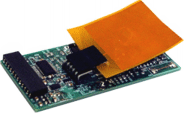
- AC or DC coupling is jumper selectable. AC coupling is suitable for applications such as measuring the ripple on a DC power supply. Multiple integral cycles are averaged for signals above 50/60 Hz. A single cycle is captured for signals from 3 Hz to 50/60 Hz. Below 3 Hz and at DC, the capture rate is every 333 ms.
 Use with current Transformers. High common mode rejection allows stable readings with current shunts located on the high side of the line. Five amp input capability allows the output of 5A current transformers to be applied directly to the transmitter, with no need for a stepdown transformer. The transmitter reading can easily be scaled for the current transformer ratio. Digital filtering is selectable for noisy signals.
Use with current Transformers. High common mode rejection allows stable readings with current shunts located on the high side of the line. Five amp input capability allows the output of 5A current transformers to be applied directly to the transmitter, with no need for a stepdown transformer. The transmitter reading can easily be scaled for the current transformer ratio. Digital filtering is selectable for noisy signals.
All signal conditioner board ranges are factory-calibrated, with calibration factors for each range securely stored in an onboard EEPROM. These factors can be scaled via software to accommodate external shunts, enabling field replacement of signal conditioner boards without necessitating recalibration of the associated transmitter. For optimal accuracy, factory recalibration is recommended annually. All Laurel Electronics instruments undergo factory calibration using the industry-leading Fluke calibrators, which are recalibrated yearly and certified traceable to national standards, ensuring the highest level of precision and reliability.
The optional extended Laureate computer board enhances Laureate transmitter by displaying rates derived from successive readings and enabling highly accurate custom curve linearization. For example, it can calculate liquid volume or flow rate in a horizontal cylindrical tank using levels from a 4-20 mA transmitter. Setup is straightforward: users input up to 180 data points into a spreadsheet or text file, and the computer calculates spline-fit segments, which are then downloaded to the transmitter for precise operation.
Laureate Transmitters are easily programmed with Laurel’s free Instrument Setup Software, downloadable from our website and compatible with Windows PCs, requiring a data interface board for setup.
High read rate of up to 50 or 60 conversions per second, the Laureate™ LT Series transmitter uses Concurrent Slope (US Pat. 5,262,780) analog-to-digital conversion to integrate signals over a full power line cycle (50 Hz or 60 Hz). This read rate enables peak and valley capture, real-time computer interfacing, and control applications. Peak and valley values are automatically captured and can be viewed using Laurel’s free Instrument Setup Software (compatible with Windows PCs) or transmitted as serial data.
Standard Hardware Features of Laureate LT Transmitters Include:
- Serial communications output, (isolated), RS232 or RS485 (half or full duplex), jumper selectable. Three protocols are user selectable: Modbus RTU, Modbus ASCII, or Laurel ASCII. Modbus operation is fully compliant with Modbus Over Serial Line Specification V1.0 (2002). The Laurel ASCII protocol is simpler than the Modbus protocol and is recommended when all devices are Laureates.
- 4-20 mA, 0-10V or -10V to +10V analog transmitter output, (isolated), jumper-selectable and user scalable. All selections provide 0.0015% resolution of output span and 0.02% output accuracy of a reading from -99,999 to +99,999 counts that is also transmitted digitally. Output isolation from signal and power grounds eliminates potential ground loop problems. Note that Ethernet data I/O is provided by Laurel's LTE series transmitters.
- Dual solid state relays, (isolated), for alarm or control. Rated 120 mA at 130 Vac or 180 Vdc.
- Selectable transducer excitation output, (isolated), user selectable 5V@100 mA, 10V@120 mA, 12V@100mA, or 24V@50 mA.
- Power 85-264 Vac, (isolated), low-voltage 10-48 Vdc or 12-32 Vac power is optional.
Digital signal filtering modes can be selected to ensure stable readings in electrically noisy environments.
- An unfiltered selection provides true peak and valley readings and aids in control applications.
- A batch average filter selection averages each 16 conversions.
- An adaptive moving average filter selection provides a choice of 8 time constants from 80 ms to 9.6 seconds. When a significant change in signal level occurs, the filter adapts by briefly switching to the shortest time to follow the change, then reverts back to its selected time constant. An Auto setting selects the time constant selection based on signal noise.
Two tare functions: auto-tare and manual tare. In auto-tare, an input line is grounded by an external pushbutton. This causes the current weight, which is normally the empty weight of the container to be stored in memory as an offset. In manual tare, the tare value can be entered manually via a control input pushbutton or using Laurel's free Instrument Setup Software.
Peak and valley values are automatically captured. These may be displayed via Laurel's free Instrument Setup Software, which runs on a PC under MS Windows or can be transmitted as serial data.
Two control inputs (CMOS/TTL levels, logic 0 = tied to digital ground, logic 1 = open) or dry contacts that can be set to control / activate 14 transmitter commands.
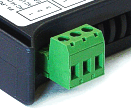
LT series DIN rail Transmitters & signal conditioners can be interfaced to a wide range of sensors and transducers using one of seven available plug-in signal conditioner boards. The transmitters duplicate the high performance (high accuracy, high read rate) and extensive programmable features of Laureate 1/8 DIN digital panel meters, counters and timers. They utilize the same signal conditioners boards, much of the same firmware, and Laurel's free Windows-based Instrument Setup Software. They come in a compact DIN rail mount package with detachable screw-clamp connectors for easy wiring.
The LT series Transmitters feature isolated, user-selectable analog outputs (4-20 mA, 0-20 mA, 0-10V, or -10V to +10V), an RS232 or RS485 serial data interface, and dual 120 mA solid state AC/DC relays. Most models, except those with temperature or AC RMS signal conditioners, include an isolated 5, 10, 12, or 24 Vdc transducer excitation output.
Connecting Laureate LT Transmitters to a Local Area Network (LAN)
Up to 30 Laureate LT Transmitters and/or Digital Panel Meters can be configured for RS485 and daisy-chained to an LT Transmitter for seamless LAN integration. Alternatively, Laurel LTE series Ethernet transmitters can connect directly to a LAN via an Ethernet cable. Setup for both configurations is streamlined using Laurel’s free Instrument Setup Software, which simplifies node discovery and transmitter configuration.
Flexible Communication Options for LT Transmitters
Laureate Transmitters can be equipped with Laurel communication boards to support various interfaces and protocols. These include serial interfaces with ASCII or Modbus RTU protocols, and Ethernet interfaces with web access, ASCII, or Modbus TCP/IP protocols, ensuring versatile connectivity for your commercial applications.
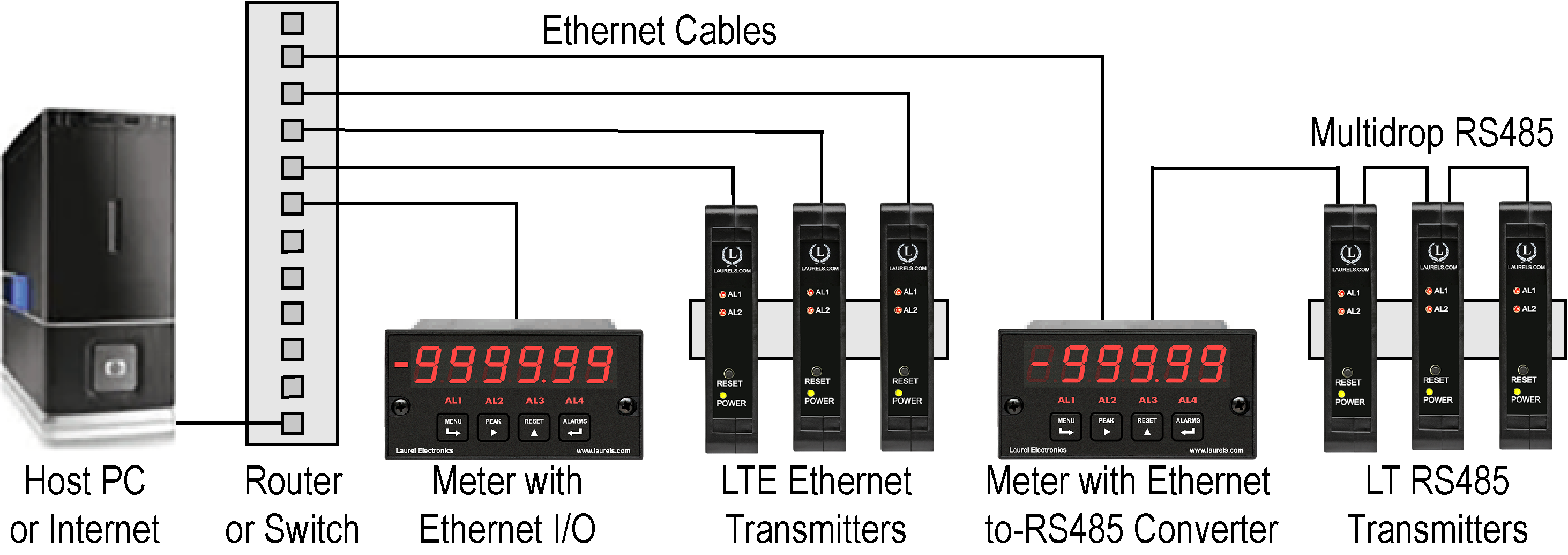
| LT Transmitter Signal Input & Function | Model Series | Analog Output | RS232 & RS485 | Dual Relays | |
|---|---|---|---|---|---|
| 1 | DC Input Voltage and Current | LT-DC |  |
 |
 |
| 2 | AC RMS Voltage or Current | LT-RMS |  |
 |
 |
| 3 | Process Voltage or Current | LT-P |  |
 |
 |
| 4 | Weighing Applications | LT-WA |  |
 |
 |
| 5 | Load Cell & Microvolt Signals | LT-WM |  |
 |
 |
| 6 | Thermocouple (Types J, K, T, E, N, R, S) | LT-TC |  |
 |
 |
| 7 | RTD Temperature | LT-RTD |  |
 |
 |
| 8 | Resistance in Ohms | LT-R |  |
 |
 |
| 9 | Frequency, Rate, Speed | LT-FR |  |
 |
 |
| 10 | Pulse Input Totalizer | LT-FR |  |
 |
 |
| 11 | Process Signal Totalizer | LT-VF |  |
 |
 |
| 12 | Sum, Difference, Ratio, Product of 2 Inputs | LT-FR |  |
 |
 |
| 13 | Batch Controller Pulse Input | LT-FR |  |
 |
 |
| 14 | Batch Controller Analog Input | LT-FR |  |
 |
 |
| 15 | On/Off Duty Cycle | LT-FR |  |
 |
 |
| 16 | Stopwatch Timing for Single Events | LT-FR |  |
 |
 |
| 17 | Average Time of Periodic Events | LT-FR |  |
 |
 |
| 18 | AC Phase Angle and Power Factor | LT-FR |  |
 |
 |
| 19 | Quadrature Position or Rate | LT-QD |  |
 |
 |
4-20 mA and RS232/RS485 transmitter for AC RMS voltage input signal
| Analog Input | Range | Resolution | Input Ohms | Error at 25°C |
|---|---|---|---|---|
| Voltage Ranges 0-100% of FS 10 Hz - 5 kHz (AC coupling) DC - 5 kHz (DC coupling) | ±200.00 mV | 10 µV | 1 MΩ | 0.03% FS ± 2 cts |
| ±2.0000 V | 100 µV | 1 MΩ | 0.03% FS ± 2 cts | |
| ±20.000 V | 1 mV | 1 MΩ | 0.03% FS ± 2 cts | |
| ±200.00 V | 10 mV | 1 MΩ | 0.03% FS ± 2 cts | |
| ±600.0 V* | 100 mV | 1 MΩ | ± 0.8 V | |
| ±300.0 V | 100 mV | 1 MΩ | ± 0.8 V | |
| * Range not ETL certified | ||||
| Recalibration: All ranges are calibrated at the factory. Recalibration is recommended every 12 months. | ||||
4-20 mA and RS232/RS485 transmitter for AC RMS current Input signal
| Analog Input | Range | Resolution | Input Ohms |
Error at 25°C |
|---|---|---|---|---|
| Current Ranges 0-100% of FS 10 Hz - 5 kHz (AC coupling) DC - 5 kHz (DC coupling) |
2.0000 mA | 0.1 µA | 100 Ω | 0.03% FS ± 2cts |
| 20.000 mA | 1 µA | 10 Ω | 0.03% FS ± 2cts | |
| 200.00 mA | 10 µA | 1 Ω | 0.03% FS ± 2cts | |
| 5.000 A | 1 mA | 0.01 Ω | ± 20 mA | |
| Recalibration: All ranges are calibrated at the factory. Recalibration is recommended every 12 months. | ||||
| Analog Output (standard) | ||||
|---|---|---|---|---|
| Output Levels | 4-20 mA, 0-20 mA, 0-10 Vdc, -10 to +10Vdc (user selectable) | |||
| Compliance, 4-20 mA | 10V (0-500Ω load) | |||
| Compliance, 0-10V | 2 mA (5 kΩ load) | |||
| Output Resolution | 16 bits (65,536 steps) | |||
| Output Accuracy | 0.02% of output span plus conversion accuracy | |||
| Output Isolation | 250V rms working, 2.3 kV rms per 1 minute test | |||
| Serial Data Output (standard) | ||||
| Signal Types | RS232 or RS485 (half or full duplex), jumper selectable | |||
| Data Rates | 300, 600, 1200, 2400, 4800, 9600, 19200 baud | |||
| Output Isolation | 250V rms working, 2.3 kV rms per 1 min test | |||
| Serial Protocols | Modbus RTU, Modbus ASCII, Custom ASCII | |||
| Modbus Compliance | Modbus over Serial Line Specification V1.0 (2002) | |||
| RS232/485 Connector | Screw terminals for easy daisy chaining | |||
| Digital Addresses | 247 for Modbus, 31 for Custom ASCII | |||
| Dual Relay Output (standard) | ||||
| Relay Type | Two solid state relays, SPST, normally open, Form A | |||
| Load Rating | 120 mA at 140 Vac or 180 Vdc | |||
| Power Input | ||||
| Standard Power | 85-264 Vac or 90-300 Vdc | |||
| Low Power Option | 10-48 Vdc or 12-32 Vac | |||
| Power Frequency | DC or 47-63 Hz | |||
| Power Isolation | 250V rms working, 2.3 kV rms per 1 min test | |||
| Power Consumption at 24V | 1.5W typical, 3W with max excitation output | |||
| Environmental | ||||
| Operating Temperature | -40°C to 70°C (-40°F to 158°F) | |||
| Storage Temperature | -40°C to 85°C (-40°F to 185°F) | |||
| Relative Humidity | 95% at 40°C, non-condensing | |||
| Cooling Required | Mount transmitters with ventilation holes at top and bottom. Leave 6 mm (1/4") between transmitters, or force air with a fan. | |||
| Mechanical | ||||
| Enclosure | Rugged black polycarbonate housing material | |||
| Mounting | 35 mm rail per DIN EN 50022 | |||
| Dimensions | 129 x 104 x 22.5 mm case | |||
| Connectors | Detachable screw clamp connectors meet VDE / IEC / UL / CSA standards. RJ45 jack for Ethernet | |||
| Tightening Torque | Screw terminal connectors: 5 lb-in (0.56 Nm) | |||
| Weight | Complete transmitter: 183 g (6.5 oz) | |||
| Replacement Case Screws | ||||
| Size | 6 | |||
| Thread Pitch | 6-19 | |||
| Length | 1/2" | |||
| Head Style | Pan Head | |||
| Drive Style | Phillips | |||
| Head Diameter | 0.256-0.270 | |||
| Head Height | 0.087-0.097 | |||
| Full/Partial Thread | Full | |||
| Drive Size | 2 | |||
| Material | Steel | |||
| Finished | Black Oxide | |||
| General | ||||
| Programming | Utilize Laurel's free Instrument Setup Software, which runs on a PC under MS Windows | |||
| Security | Lockout options available using Laurel's free Instrument Setup Software | |||
| Warranty | 3 years parts & labor | Recalibration: All ranges are calibrated at the factory. Recalibration is recommended every 12 months. | ||
| * For purposes of accuracy calculation, the 600V range is 2000V (20,000 counts), and the 5A range is 20A (20,000 counts). | ||||
Transmitter Pinout
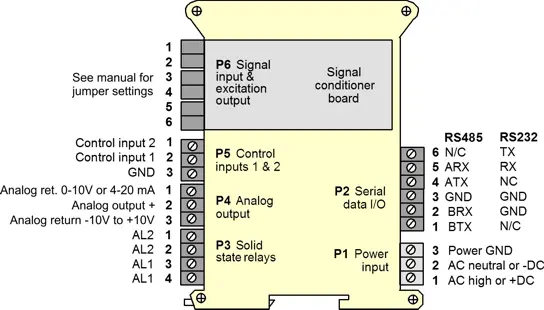
Free Instrument Setup Software for Series 2 Laureates
Free Downloadable Windows-based Instrument Setup (IS) software (Data Interface Board Required) for use with our programmable Digital Panel Meters, Scale Meters, Counters, Timers, Remote Displays, and Transmitters, are an easy method to set up Laureate 1/8 DIN digital panel meters, counters, timers, remote displays, and DIN-rail transmitters, as explained in the Instrument Setup Software Manual. Laureate 1/8 DIN instruments can also be set up from the front panel, as explained in their respective Owners Manuals. Instrument Setup software is of benefit whether or not the PC is connected to the instrument.
- When the PC is connected to the instrument, Instrument Setup software can retrieve the setup file from the instrument or open a default setup file or previously saved setup file from disk View Setup, then provides graphical user interface (GUI) screens with pull-down menus applicable to input, display, scaling, filtering, alarms, communications, analog output, and front panel lockouts. Fields that are not applicable to the instrument as configured are either left out or grayed out. Clicking on any item will bring up a detailed Help screen for that item. After editing, the setup file can be downloaded, uploaded to the instrument, or saved to a disk. The same setup file can then be downloaded into multiple instruments.
- When the PC is not connected to the instrument, the above GUI screens can be used to set up a virtual instrument. The setup file can then be saved to disk. Switching toView Menu then brings up a screen with the required front panel programming steps. This view can be printed out for use at the instrument site and to serve as a hard copy record.
Download Free Instrument Setup Software
Installation
Set User Account Control (UAC) of MS Windows to "Never notifiy me" so that Instrument Setup Software can create directories. The UAC change screen can be reached as follows:
- Under Windows 7, click on the Windows Start button in the lower left of the desktop and enter "UAC" in the search field.
- Under Windows 8, navigate to Control Panel, then to the "User Accounts and Family Safety" section, and click on "Change User Account Control Settings."
- Under Windows 10, click on the Windows Start button in the lower left of the desktop, then on "Settings", and enter "UAC" in the search field.
- Reboot your computer for the changed UAC setting to take effect.

RJ11-to-DB9 cable with rear view of DB9 connector to PC

RS232 cable, meter to PC, P/N CBL01
Laureate 1/8 DIN Laureate instruments must be equipped with a serial communications board and be connected to the computer via a serial communications cable. The connection can be via RS232, RS485, USB or Ethernet. Following setup, the serial communications board may be removed from the instrument if desired. The wiring of the RS232 cable is illustrated above with end views of the two connectors.
Laureate LT Series transmitters come standard with a 3-wire serial interface, which can be jumpered for RS232 or RS485.
Laureate LTE Series transmitters come standard with an Ethernet interface.
Meter Setup Screens
Click on any of the reduced screens below for a full-size screen view, then click on the Back button of your browser to return to this page. The screens examples below are for a fully-loaded Series 2 Digital Panel Meter (DPM), which is connected to the PC via RS232. If the meter is a Series 1 meter (pre-2007), this is sensed by the software, and somewhat different screens are brought up. Please see Series 1 setup screens.











Meter Setup Utilities




From the Main Menu, click on Readings if your PC is connected to the meter. A pull-down menu then offers three choices: List, Plot and Graph.
- List presents the latest readings in a 20-row by 10-column table. Press Pause at any time to freeze the display. This is one method to capture peak readings.
- Plot generates a plot of readings vs. time in seconds. It effectively turns the DPM-PC combination into a printing digital oscilloscope.

- Graph generates a histogram where the horizontal axis is the reading and the vertical axis is the number of occurrences of readings. The display continually resizes itself as the number of readings increases.



Dimensions
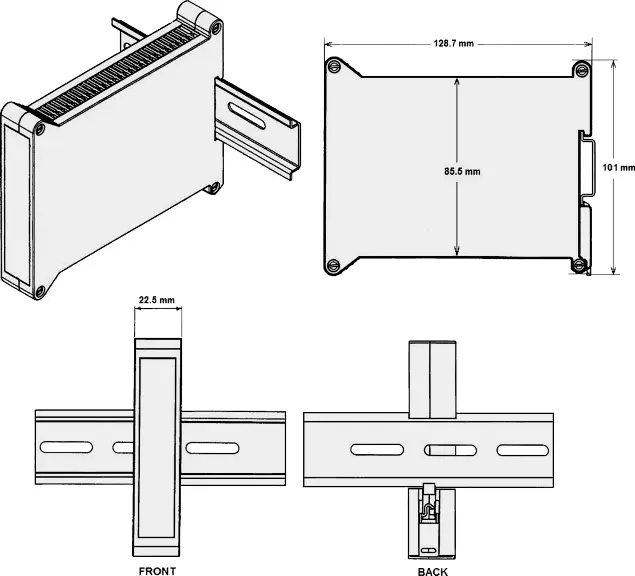
Dimensioned CAD assembly drawings in EPRT, STEP, x_t, .dwg, pdf file formats: Laureate-transmitter-case.zip (zipping prevents browser from opening CAD files as text files).
CAL-Analog
Certificate of Calibration
$65.00CBL02
USB-to-RS232 Adapter Cable
$47.00CBL04
RS232 Cable for LT Transmitters
$47.00What Defines an LT DIN Rail Analog Transmitter with Serial Data Communication and Analog Outputs for True RMS AC Voltage?
In today’s industrial and automation environments, precise and dependable measurement of electrical parameters is vital. One such parameter, True RMS (Root Mean Square) AC voltage, is key to assessing the performance and condition of electrical systems. Devices like the LT DIN Rail Analog Transmitter, equipped with serial data communication and analog outputs, are designed to support this need. This article investigates these devices, their operation, and their significance across various applications as of 03:28 PM PDT on Monday, July 14, 2025.
Understanding True RMS AC Voltage
Before exploring the LT DIN Rail Analog Transmitter, it’s essential to grasp True RMS AC voltage. RMS (Root Mean Square) quantifies the magnitude of a fluctuating value, particularly significant in AC (Alternating Current) circuits. It represents the DC voltage equivalent that would deliver the same power to a resistive load.
True RMS measurement is crucial as it offers a true reflection of power usage, accounting for waveform variations. Unlike basic average or peak readings, it captures all waveform nuances, making it indispensable for systems requiring exact power assessments in 2025.
What is an LT DIN Rail Analog Transmitter?
The LT DIN Rail Analog Transmitter is a specialized instrument crafted to measure electrical parameters, such as True RMS AC voltage, and convert them into standardized output signals for further analysis or monitoring. The "LT" often indicates a specific product line or series, recognized for its durability and precision.
These transmitters are typically installed on a DIN rail, a standard metal rail widely used to mount circuit breakers and industrial control equipment within racks. This mounting method simplifies installation and ensures a secure fit in control panels as of mid-2025.
Key Features of LT DIN Rail Analog Transmitters
-
True RMS Measurement: As noted, True RMS measurement is essential for precise power evaluation. These transmitters accurately determine the True RMS value of AC voltage, delivering reliable data.
-
Analog Outputs: The transmitter transforms measured voltage into analog signals, typically 4-20 mA or 0-10 V, which are easily integrated with industrial devices like PLCs (Programmable Logic Controllers), SCADA systems, or data loggers.
-
Serial Data Communication: Many LT DIN Rail Analog Transmitters feature serial communication options, such as RS-485 or Modbus RTU, enabling digital network connectivity for remote monitoring and control. This is especially valuable in 2025’s distributed systems requiring centralized oversight.
-
High Accuracy and Reliability: Engineered for precision within ±0.5% or better, these transmitters perform reliably in tough industrial conditions, incorporating features like temperature compensation, noise reduction, and over-voltage protection.
-
Compact and Modular Design: The DIN rail mounting supports a space-saving, modular setup, allowing multiple transmitters to be mounted adjacent to each other, enhancing wiring efficiency.
Applications of LT DIN Rail Analog Transmitters
LT DIN Rail Analog Transmitters with True RMS measurement capabilities are applied in diverse industrial contexts, including:
- Power Monitoring: Tracks AC voltage in distribution systems to ensure stable and efficient performance in 2025.
- Energy Management: Analyzes power usage in industrial facilities to improve energy efficiency.
- Electrical Safety: Identifies abnormal voltage levels that may signal safety risks, such as equipment malfunctions or short circuits.
- Automation Systems: Supplies accurate voltage data to PLCs and control systems for automated decisions and adjustments.
- Test and Measurement: Utilized in labs for precise voltage assessments in electrical testing and research projects.
Conclusion
The LT DIN Rail Analog Transmitter with serial data communication and analog outputs for True RMS AC voltage is a cornerstone of modern electrical and industrial systems as of July 14, 2025. It delivers accurate, dependable voltage measurements, ensuring efficient and safe operations. With its True RMS capability, serial connectivity, and standardized analog outputs, this transmitter is a versatile solution for applications ranging from power monitoring to automation and beyond, supporting informed decision-making by engineers and technicians.
Recognizing the functionality and potential of these transmitters can guide professionals in leveraging them effectively across various electrical and industrial settings.
Where is an LT DIN Rail Analog Transmitter with Serial Data Communication and Analog Outputs for True RMS AC Voltage Used?
In the field of industrial automation and control, precise measurement and robust data transmission are essential. The LT DIN Rail Analog Transmitter with Serial Data Communication and Analog Outputs for True RMS AC Voltage is an advanced device that connects analog signals with digital data systems. Here’s an in-depth look at its applications and importance as of 03:28 PM PDT on Monday, July 14, 2025:
Understanding the Device
Before exploring its applications, it’s key to understand the device’s core capabilities:
- True RMS Measurement: The transmitter precisely calculates the root mean square (RMS) value of an AC voltage signal, critical for capturing the effective value of varying or non-sinusoidal waveforms.
- Analog Outputs: It generates continuous analog output signals proportional to the measured voltage, suitable for further analysis or display.
- Serial Data Communication: Enables digital communication via serial interfaces, supporting integration with data acquisition and control systems.
Applications of LT DIN Rail Analog Transmitter
-
Industrial Automation:
- Monitoring Electrical Systems: In industrial environments, consistent monitoring of electrical systems is vital. This transmitter measures AC voltage in machinery and equipment, providing critical data for diagnostics and upkeep.
- Control Systems Integration: Analog outputs allow integration with existing control systems, enabling real-time monitoring and automated adjustments based on voltage data.
-
Energy Management:
- Power Quality Monitoring: By assessing true RMS voltage, the transmitter identifies power quality issues like sags or surges, promoting efficient energy use in 2025.
- Load Analysis: Energy managers utilize these measurements to evaluate and optimize electrical loads, enhancing overall efficiency.
-
Building Automation:
- HVAC Systems: In building automation, particularly HVAC setups, accurate voltage measurement ensures proper functioning of electrical components.
- Lighting Controls: The transmitter supports systems needing voltage feedback for effective lighting management and energy conservation.
-
Safety and Protection Systems:
- Electrical Safety: Continuous voltage monitoring helps detect unsafe conditions or faults, allowing timely interventions to protect equipment and personnel.
- Predictive Maintenance: Regular analysis of voltage signals aids in anticipating failures, supporting proactive maintenance in 2025.
-
Research and Development:
- Experimental Setups: Researchers and engineers rely on these transmitters for accurate AC voltage measurement in developing and testing new technologies.
- Data Acquisition Systems: The serial data feature integrates with complex data acquisition systems for thorough analysis and recording.
Conclusion
The LT DIN Rail Analog Transmitter with Serial Data Communication and Analog Outputs for True RMS AC Voltage is a versatile and critical tool across industrial, commercial, and research fields as of July 14, 2025. Its precision in measurement and seamless digital integration make it invaluable for monitoring, regulating, and analyzing modern electrical and automation systems. Whether enhancing energy efficiency, ensuring safety, or advancing research, this device is pivotal in maintaining operational excellence across diverse settings.
Less Information.








